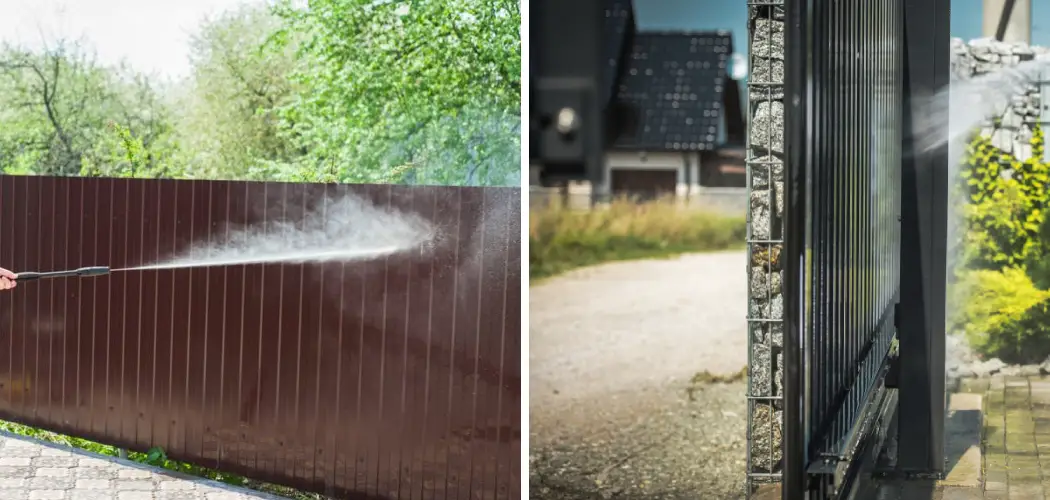Black aluminum fences are renowned for their sleek appearance and formidable durability, offering a sophisticated boundary for any property. However, despite their robust nature, they are not impervious to the elements; dirt, grime, and discoloration can mar their beauty over time.
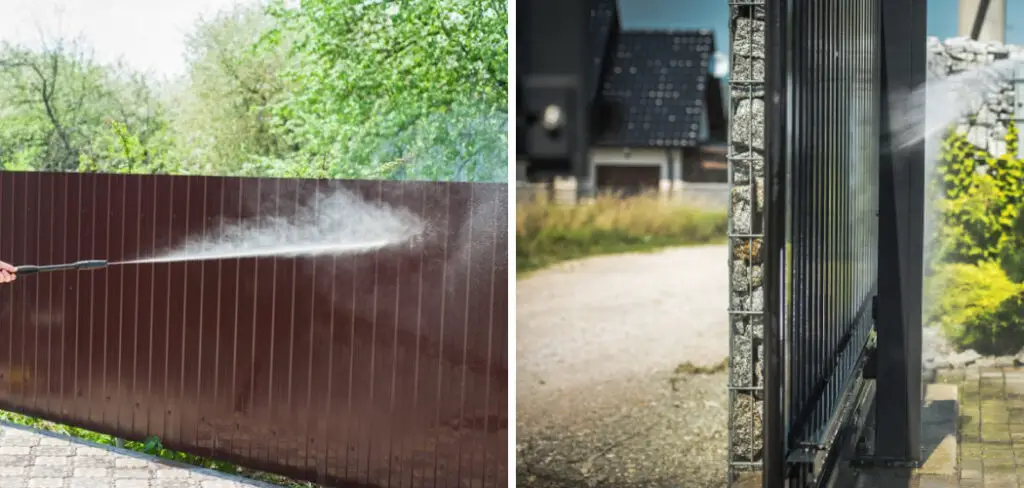
This comprehensive guide will delve into the nuances of how to clean black aluminum fence effectively, ensuring it remains a stunning feature of your home. From gentle cleaning techniques for everyday dust to more robust methods for stubborn stains and weather-induced wear, you’ll learn to maintain your fence’s alluring finish with ease.
Understanding the Finish and Potential Issues
The finishes on black aluminum fences typically include powder coating, anodization, and paint. Powder-coated surfaces are known for their resilience, offering resistance to chipping, scratching, and fading. Yet, they require careful handling—a gentle cleaning agent is recommended to preserve the integrity of the coating.
Anodized aluminum has a naturally hardened surface that is less prone to corrosion but can be sensitive to alkaline-based cleaners, which can discolor the finish. Use non-abrasive tools and mild detergents for painted aluminum to avoid stripping the paint. Irrespective of the finish, harsh chemicals can react unpredictably and may lead to permanent damage, such as etching or dulling of the surface.
Common cleaning issues that owners face include oxidation, presenting as a chalky residue that, if left unchecked, can compromise the metal; water stains, which occur from mineral deposits left after water evaporates; and stubborn dirt or grime accumulation that can adhere strongly to the fence’s textured areas.
Addressing these issues without damaging the finish is critical when selecting cleaning methods and materials for your black aluminum fence.
Gathering Cleaning Supplies and Choosing the Right Method
Embarking on your fence cleaning journey begins with assembling the correct arsenal of cleaning supplies. Essential items include mild dish soap—a must for its gentle yet effective cleaning properties. White vinegar and baking soda are handy for their natural abrasive and disinfectant qualities. These agents act as powerful allies against grime when armed with soft cloths and sponges, which are kind to your fence’s finish. Additionally, using a garden hose will enable you to give your fence a thorough rinse without risking too much pressure.
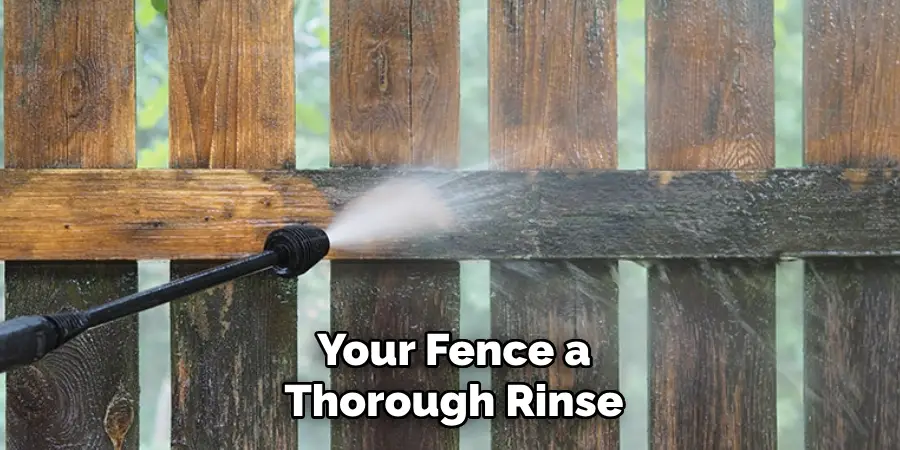
An extension ladder can be invaluable for those challenging-to-reach spots or if you’re dealing with extensive surface areas. Meanwhile, a pressure washer might be tempting to use for its efficiency; however, caution is essential. Avoid employing it on high settings to prevent any potential harm to your fence’s finish, such as chipping or peeling, and ensure you adjust the nozzle for a wider, gentler stream.
Choosing the appropriate cleaning method is paramount to the longevity of your fence. Evaluate the soil level and the finish type before selecting your tools and solutions. A simple soapy water mix will do for light dirt on powder-coated surfaces.
Tougher grime on an anodized finish may require a vinegar-based solution. At the same time, painted surfaces often respond well to soapy water, followed by a baking soda paste for any persistent stains.
For eco-conscious individuals, consider eco-friendly alternatives like plant-based detergents and soaps. These options often eschew harsh chemicals in favor of natural cleaning power, reducing your environmental footprint while still ensuring a sparkling fence. Always remember to spot-test any cleaner on a small, inconspicuous area to forestall unexpected reactions like discoloration or damage.
Preparing the Fence and Safety Precautions
Before cleaning, it’s essential to remove any loose debris, such as leaves, twigs, and cobwebs, that have accumulated on your black aluminum fence. A gentle brush or a dry cloth can be used for this purpose to avoid scratching the finish. Surrounding plants and landscaping should be shielded from exposure to cleaning solutions by covering them with tarps or plastic sheets, as runoff can harm vegetation.
Safety must not be taken lightly while handling cleaning products. Always wear gloves to protect your skin from irritation and eye protection to prevent accidental splashes into your eyes. When mixing and applying the cleaning solutions, make sure the area is well-ventilated to avoid inhaling fumes.
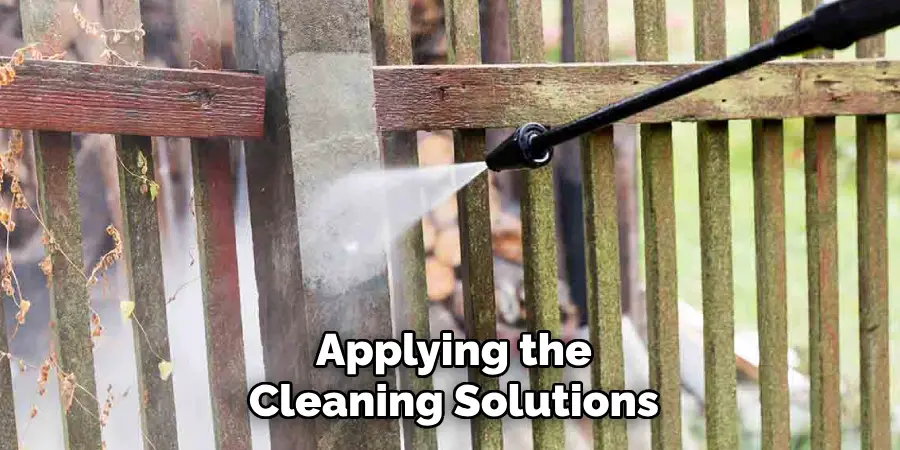
Even though you may be tempted to expedite the cleaning process, caution is warranted against using abrasive cleaners, scouring pads, or pressure washers at high settings, which could irreparably damage the delicate finish of your fence.
Always opt for the gentlest cleaning techniques that will be effective, keeping the long-term health of your fence’s surface as a priority. Remember, protecting the integrity of your black aluminum fence during cleaning is just as important as the cleaning itself.
How to Clean Black Aluminum Fence: A Detailed Guide
1. Simple Cleaning for Light Dirt and Dust
When dealing with light dirt and dust accumulation, a straightforward and effective approach is the use of mild dish soap mixed with warm water. This solution is potent enough to break down the dust and dirt particles without being harsh enough to compromise the integrity of your black aluminum fence’s finish.
To prepare the cleaning mixture, fill a bucket with warm water and add a few squirts of mild dish soap. Stir gently until you see soap suds form, indicating that the soap is evenly distributed throughout the water. For this method, you should avoid using abrasive detergents with a high chemical concentration, as they could damage the fence’s coating.
With your soapy water ready, dip a soft cloth or sponge into the mixture and wring it out to prevent excess liquid from dripping. Starting at the top and working your way down, gently scrub the fence’s surfaces in a circular motion. This technique ensures that you cover the entire area without allowing the dirt to settle back onto the surfaces you’ve already cleaned.
It’s crucial to work in sections — tackle a manageable portion of the fence before moving on to the next, ensuring no spots are missed and that the soapy water doesn’t dry onto the surface, which might cause streaking.

After washing a section, rinse the area thoroughly with water to remove all soap residue. A garden hose with a gentle spray setting is perfect for this task, offering an easy and effective rinse without imposing damage from excessive water pressure.
Once the fence is washed and rinsed, it’s time for drying. For a streak-free finish, using a clean microfiber cloth is advisable. These cloths are highly absorbent and soft and will not scratch the coating on your fence. Gently pat the wet surfaces or drag the cloth in one direction to dry the fence. Microfiber cloths are also effective in trapping any remaining dust and giving your fence that pristine appearance.
This simple routine can maintain the aesthetic value of your fence; by regularly cleaning with soap and water, you ensure that light dirt and dust do not accumulate, thus preventing more stubborn staining that requires harsher cleaning measures. Moreover, it extends the life of your fence by keeping potentially corrosive substances at bay and maintains a pleasing curb appeal with minimal effort.
2. Removing Stubborn Grime and Stains
While light cleaning suffices for everyday maintenance, your black aluminum fence might occasionally require a more potent solution to tackle stubborn grime and stains. White vinegar is an excellent natural cleaning agent that can effectively remove tougher dirt without the harshness of chemical cleaners. To use vinegar safely and effectively, it’s crucial to dilute it properly with water, creating a mixture that’s strong enough to cleanse without causing damage.
Begin by mixing equal parts of white vinegar and water in a bucket to create your cleaning solution. This diluted mix is typically gentle enough for most fence finishes but still has the acidity necessary to break down more resistant grime.
Before proceeding with a full-scale cleanup, apply a small amount of the diluted vinegar solution to a concealed part of the fence. Test to ensure that it does not have any adverse effects, like etching or discoloration on the finish.

Once you have confirmed the cleaner’s safety, pour the solution into a spray bottle for easy application. Spritz the affected areas liberally, allowing the mix to cling to the grime, and let it sit for a few minutes to penetrate and loosen the dirt. Do not let it dry fully; this could make the grime stickier and more challenging to remove.
After letting the vinegar solution sit, gently scrub the stained areas with a soft brush or cloth. You might notice the grime lifting away as the acidity of the vinegar acts on the stains. Once the area is treated, rinse it thoroughly with a gentle stream of water from your garden hose, ensuring all vinegar residue is washed away, which, if left behind, could attract dirt and cause streaking.
Making a baking soda paste can be highly effective for particularly persistent stains that resist vinegar cleaning. This paste is created by mixing baking soda with just enough water to create a thick, spreadable consistency. Gently apply the paste onto the stained area with a cloth or sponge, letting it sit for 15 to 20 minutes, allowing the natural abrasive quality of the baking soda to lift the stain from the fence’s surface.
After the allotted time, rinse the area with clean water using a soft, gentle spray setting. The combination of these natural ingredients – vinegar and baking soda – can address nearly any stain you might encounter on your black aluminum fence without resorting to harsh chemicals.
Always conduct a spot test on an inconspicuous area to verify that your chosen cleaning method is safe for the fence’s coating. By approaching tougher cleaning challenges with these natural solutions, you not only preserve the integrity of your fence but also contribute to a healthier environment.
3. Dealing with Oxidation and Water Stains
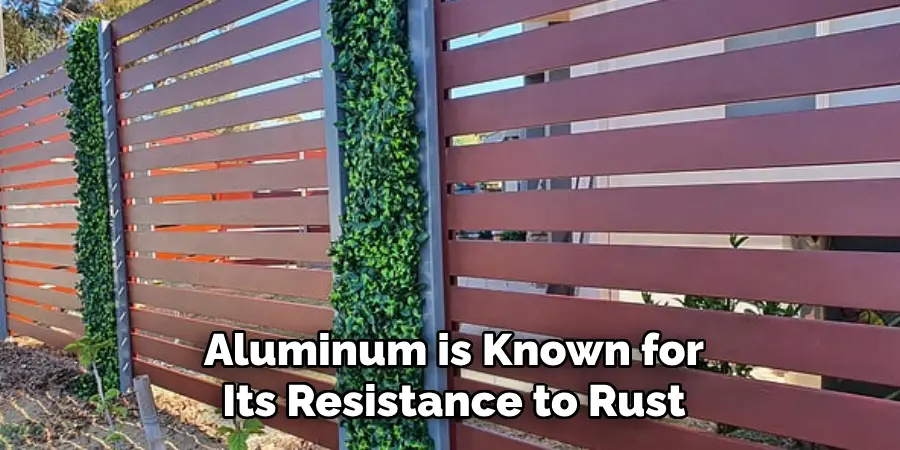
Aluminum is known for its resistance to rust, but it is not entirely immune to the effects of oxidation. Over time, aluminum fences can develop a dull, chalky appearance, which is a clear sign of oxidation. This occurs when the metal reacts with oxygen, forming aluminum oxide on its surface. While this layer can protect the underlying metal from further degradation, it detracts from the fence’s aesthetic appeal.
Addressing oxidation early is essential as it prevents the layer from thickening and becoming more difficult to remove, thereby preserving the aluminum’s integrity and appearance.
For minor cases of oxidation, a gentle yet effective method is to use a mixture of white vinegar and water. Mix equal parts of vinegar and water in a bucket as with stain removal. With a soft cloth or a non-abrasive pad, apply the mixture to the affected fence areas, allowing it to sit for a few minutes.
The mild acidity of the vinegar will help to loosen and lift the oxidation from the fence. After treating the areas, rinse the fence thoroughly with a gentle stream of water and dry it off with a clean microfiber cloth to prevent new water stains from forming.
When dealing with more stubborn oxidation, it may be necessary to resort to a commercial aluminum cleaner designed for this purpose. These products can offer more powerful agents that deal with severe oxidation. Follow the product instructions carefully to ensure you do not damage the fence’s finish. Apply the cleaner using a soft brush, gently working it into the areas with oxidation, and rinse thoroughly afterward.
To prevent water stains, ensure the aluminum fence is dried off every time it is cleaned. Water stains can form when droplets are left to evaporate on the surface, leaving behind mineral deposits. Maintaining a clean gutter system can also prevent dirty water from splashing onto the fence during rainstorms, which can further reduce the incidence of water staining.
In conclusion, regular maintenance, including oxidation and water stain removal, maintains the visual appeal of a black aluminum fence and can extend its longevity.
Using nonabrasive, eco-friendly cleaning methods such as white vinegar and water can effectively tackle early signs of oxidation. For more severe cases, a specialized cleaner can be a valuable tool. Lastly, preventative measures like drying off the fence after cleaning and ensuring clean gutters will keep your fence looking pristine and spotless for years to come.
That’s it! You’ve now learned how to clean black aluminum fence without resorting to harsh chemicals and how to address oxidation and water stains effectively. With these tips, you can maintain your fence’s beauty while promoting a healthier environment.
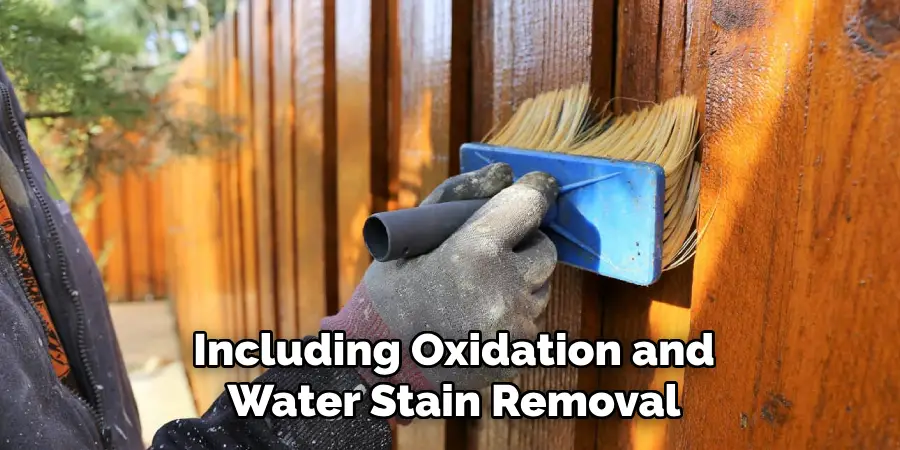
Remember always to conduct spot tests before proceeding with full-scale cleaning and regularly inspect your fence for any signs of damage or wear. By following these guidelines, you can enjoy a clean, well-maintained aluminum fence for many years to come.
Additional Tips and Tricks
Maintaining the stunning appearance of a black aluminum fence requires a commitment to regular cleanings, thereby preventing the buildup of dirt and grime that can become harder to remove over time. A disciplined schedule of light cleaning every few weeks can keep your fence looking fresh and reduce the need for more intensive treatments.
Occasionally, you might encounter heavily soiled patches in areas that are difficult to reach. In such cases, it’s prudent to consider enlisting professional cleaning services. These experts have specialized equipment and techniques to safely and effectively restore your fence without the risk of damage that might come from more aggressive DIY methods.
Try applying a thin layer of car wax or furniture polish for avid DIY enthusiasts aiming to bring back the luster to a fence that has turned dull. These common household items can add shine and protect against the elements. When applying car wax or polish, be sure to use a soft cloth and follow the product’s instructions for the best results.
It’s vital to store your cleaning supplies properly after use. Keep brushes, cloths, and solutions in a dry, cool place to ensure their longevity and readiness for your next cleaning session. Moreover, it’s crucial to dispose of used cleaning solutions responsibly. Avoid pouring leftover vinegar or baking soda mixtures directly into the ground or down household drains. Instead, adhere to local guidelines for disposing of such substances, thereby minimizing the impact on the environment.

Through these additional tips and tricks, you can keep your black aluminum fence looking its best and do so in a manner that considers the environment and the proper care of your cleaning supplies. Regular upkeep and these savvy practices will ensure your fence is a testament to beauty and responsibility.
Conclusion
In essence, this guide illustrates how to clean black aluminum fence with precision to uphold its striking presence in your landscape. The key takeaways highlight the importance of utilizing gentle, environmentally friendly methods for routine maintenance and addressing oxidation promptly.
Choosing the right cleaning method is crucial to ensure the finish remains unblemished, empowering the fence to resist the elements. Employing expert services or products can be beneficial for more challenging tasks or restoration.
By embracing consistent cleaning and care, you can enjoy the enduring elegance and luster of your black aluminum fence, which enhances your property’s curb appeal and symbolizes your dedication to aesthetics and responsible stewardship.
About
Outdoor Fixes is a distinguished figure in the world of Diy design, with a decade of expertise creating innovative and sustainable Diy solutions.
His professional focus lies in merging traditional craftsmanship with modern manufacturing techniques,
fostering designs that are both practical and environmentally conscious. As the author of diy,
outdoorfixes delves into the art and science of outdoorfixes-making, inspiring artisans and industry professionals alike.
Education RMIT University
(Melbourne, Australia) Associate Degree in Design (Outdoor Fixes) Focus on sustainable design, industry-driven projects,
and practical craftsmanship. Gained hands-on experience with traditional and digital manufacturing tools, such as CAD and CNC software.
Nottingham Trent University
(United Kingdom) Bachelor’s in outdoorfixes.com and Product Design (Honors) Specialized in product design with a focus on blending creativity with production
techniques. Participated in industry projects, working with companies like John Lewis and Vitsoe to gain real-world insights.
Publications and Impact
In diy, Outdoor Fixes his insights on indoor design processes, materials, and strategies for efficient production.
His writing bridges the gap between artisan knowledge and modern industry needs, making it a must-read for both budding designers and seasoned professionals.

